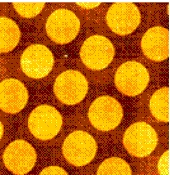
Physik Supramolekularer Systeme, Universität Bielefeld, Fakultät für Physik and Bielefeld Institute for Biophysics and Nanoscience (BINAS), Universitätsstr. 25, D-33615 Bielefeld, Germany

 |
Armin Gölzhäuser
Physik Supramolekularer Systeme, Universität Bielefeld, Fakultät für Physik and Bielefeld Institute for Biophysics and Nanoscience (BINAS), Universitätsstr. 25, D-33615 Bielefeld, Germany |
 |
A major goal in nanotechnology is the preparation and manipulation of supramolecular objects with nanometer dimensions. For this task, it is essential to develop tools that can build nanoscale templates for molecular self-assembly. The modification of surface bound self-assembled monolayers by e-beam lithography allows the fabrication of molecular surface structures with dimensions of a few nm. Functionalized aromatic self-assembled monolayers are particularly useful for e-beam patterning, as the impinging electrons dehydrogenate and cross-link the underlying aromatic cores, and chemically convert the terminal group, for example from nitro to amino. Hence, lithography creates localized surface groups to which other molecules may be coupled. These molecular patterns can be transferred into metals and semiconductors, and they can be utilized for the laterally controlled electrochemical deposition. More generally, molecular templates can be used to immobilize various molecular entities (dyes, polymers, biomolecules) on surfaces. Finally, the molecular surface patterns can be used for the controlled preparation of individual nanosheets and free-standing membranes which have the thickness of a single molecule.